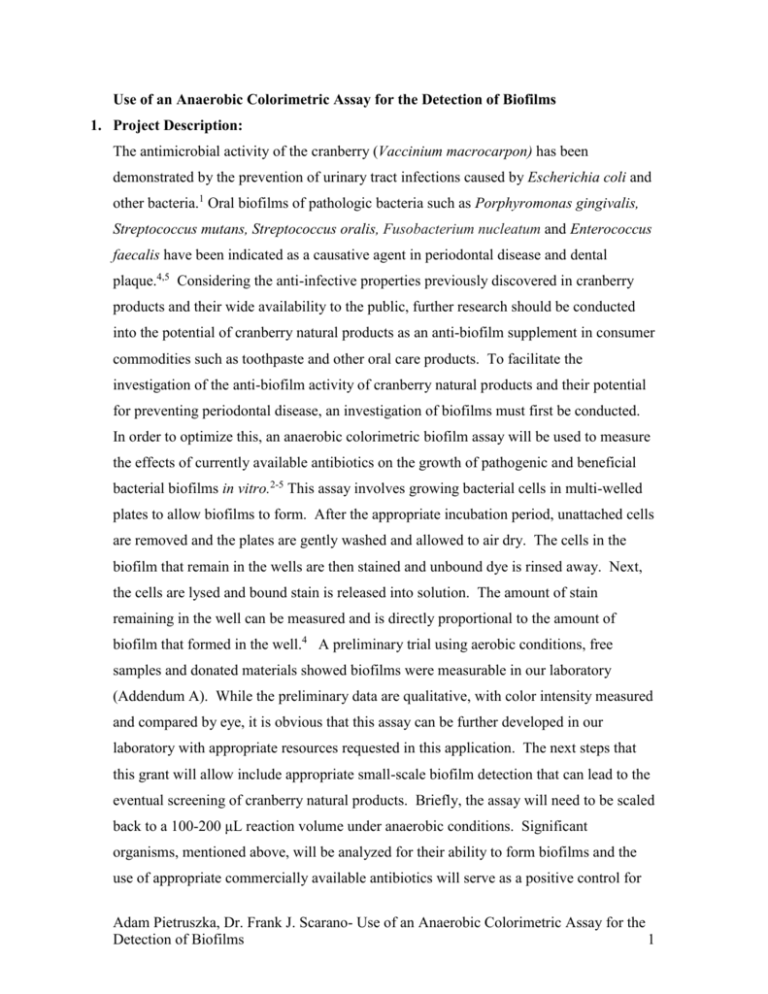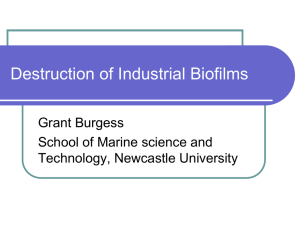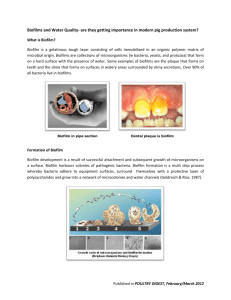14 OUR Proposal - Adam Pietruszka Research
advertisement

Use of an Anaerobic Colorimetric Assay for the Detection of Biofilms 1. Project Description: The antimicrobial activity of the cranberry (Vaccinium macrocarpon) has been demonstrated by the prevention of urinary tract infections caused by Escherichia coli and other bacteria.1 Oral biofilms of pathologic bacteria such as Porphyromonas gingivalis, Streptococcus mutans, Streptococcus oralis, Fusobacterium nucleatum and Enterococcus faecalis have been indicated as a causative agent in periodontal disease and dental plaque.4,5 Considering the anti-infective properties previously discovered in cranberry products and their wide availability to the public, further research should be conducted into the potential of cranberry natural products as an anti-biofilm supplement in consumer commodities such as toothpaste and other oral care products. To facilitate the investigation of the anti-biofilm activity of cranberry natural products and their potential for preventing periodontal disease, an investigation of biofilms must first be conducted. In order to optimize this, an anaerobic colorimetric biofilm assay will be used to measure the effects of currently available antibiotics on the growth of pathogenic and beneficial bacterial biofilms in vitro.2-5 This assay involves growing bacterial cells in multi-welled plates to allow biofilms to form. After the appropriate incubation period, unattached cells are removed and the plates are gently washed and allowed to air dry. The cells in the biofilm that remain in the wells are then stained and unbound dye is rinsed away. Next, the cells are lysed and bound stain is released into solution. The amount of stain remaining in the well can be measured and is directly proportional to the amount of biofilm that formed in the well.4 A preliminary trial using aerobic conditions, free samples and donated materials showed biofilms were measurable in our laboratory (Addendum A). While the preliminary data are qualitative, with color intensity measured and compared by eye, it is obvious that this assay can be further developed in our laboratory with appropriate resources requested in this application. The next steps that this grant will allow include appropriate small-scale biofilm detection that can lead to the eventual screening of cranberry natural products. Briefly, the assay will need to be scaled back to a 100-200 μL reaction volume under anaerobic conditions. Significant organisms, mentioned above, will be analyzed for their ability to form biofilms and the use of appropriate commercially available antibiotics will serve as a positive control for Adam Pietruszka, Dr. Frank J. Scarano- Use of an Anaerobic Colorimetric Assay for the Detection of Biofilms 1 anti-biofilm activity. Once established in our laboratory, the assay will be perfectly poised to begin screening cranberry natural products for anti-biofilm activity. This will open the door to further research questions, including the efficacy of cranberry natural products against multi-drug resistant organisms (MDRO) and other pathogenic organisms such as Candida albicans. Past research conducted by Drs. Neto and Scarano involving antimicrobial activities of natural products from cranberries has shown that this area has great potential.1,6 Upon completion of the project, a full sized research poster disseminating laboratory findings and conclusions will be produced and presented in the Department of Medical Laboratory Science and the University’s Sigma Xi research exhibit. This poster will be made available to the OUR upon request. Project Impact: This research not only impacts my work as a student in the MLS program, but can also have an extremely important effect on oral health and perhaps even effective treatment of infections caused by MDRO. Periodontal disease has been reported in 8.52% of adults aged 20-64 and a staggering 17.20% of seniors aged 65 or older, according to the National Health and Nutrition Examination Survey and MDROs are becoming a more serious issue in the health care profession.7,8 With the over use of traditional antibiotics and an increased number of hospital-acquired infections, along with a pronounced difference between the periodontal disease rate in the population, an alternative form of treatment or supplements should be investigated. The development of this assay in our laboratory will eventually allow us to screen cranberry natural products for their antibiofilm activity in organisms that are known to cause periodontal disease. The assay will also allow us to screen cranberry natural products for their anti-microbial effects against MDRO. Adam Pietruszka, Dr. Frank J. Scarano- Use of an Anaerobic Colorimetric Assay for the Detection of Biofilms 2 2. Budget Item Price Organisms (ATCC) $150 Microtiter plates (Fisher) $150 Anaerobic generators (Fisher) $75 Antibiotics (Fisher) $75 Poster printing $50 Total $500 3. Additional Funding For this initial investigation no other funding sources have been sought. However, future application may be made to The Cranberry Institute, the Education and Research fund of the American Society of Clinical Laboratory Science (ASCLS) and other local, regional and federal granting agencies. 4. Other Financial Support In-kind donations are available from generous UMD MLS alumni including but not limited to various growth media and nutrients, stains and buffer solutions. Free samples from Corning Inc. have been exhausted. References 1. 2. 3. 4. 5. Kunal D Patel. Inhibition of Human Fungal Pathogens by Polyphenols Isolated from Cranberry Fruit(Vaccinium macrocarpon). University of Massachusetts, Dartmouth Master’s Thesis. 2011 May. AJ McBain. Chapter 4; In Vitro Biofilm Models; An Overview. Advances in Applied Microbiology. 2009; 69: 99-132. Gregory Richard L. Personal Communication. Analysis of S. mutans Biofilm: Inhibition of Formation and Reduction of Existing Biofilm and Glucosyltransferase and Acid Production Dilution Follow-up Report. A Yamanaka, Kouchi T, Kasai K, Kato T, Ishihara K, Okuda K. Inhibitory Effect of Cranberry Polyphenol on Biofilm Formation and Cysteine Proteases of Porphyromonas gingivalis. J Periodont. 2007; 42: 589-592. C Y Loo, Corliss D A, Ganeshkumar N. Streptococcus gordonii Biofilm Formation: Identification of Genes that Code for Biofilm Phenotypes. J Bacteriology. 2000 Mar; 182(5): 1374-1382. Adam Pietruszka, Dr. Frank J. Scarano- Use of an Anaerobic Colorimetric Assay for the Detection of Biofilms 3 6. 7. 8. Catherine Neto, Patel K, Boddeti R, Dovell A, Carpenter J, Scarano F, Caruso F, Luchsinger S, Hicks J, Colson K. Proanthocyanidins from Cranberry Fruit and Leaves (Vaccinium Macrocarpon): Structure Variation and Antimicrobial Properties. University of Massachusetts, Dartmouth. 2009. Periodontal Disease in Adults (Age 20-64) [Internet]. Maryland: National Institute of Dental and Craniofacial Research [updated 2014 January 6; cited 2014 February 10]. Available from: http://www.nidcr.nih.gov/DataStatistics/FindDataByTopic/GumDisease/Periodont aldiseaseAdults20to64 Periodontal Disease in Seniors (Age 65 and Over) [Internet]. Maryland: National Institute of Dental and Craniofacial Research [updated 2014 January 6; cited 2014 February 10]. Available from: http://www.nidcr.nih.gov/DataStatistics/FindDataByTopic/GumDisease/Periodont aldiseaseSeniors65over Adam Pietruszka, Dr. Frank J. Scarano- Use of an Anaerobic Colorimetric Assay for the Detection of Biofilms 4 Addendum A : A Modified Biofilm Assay Trial – Procedure Adam Pietruszka Department of Medical Laboratory Science University of Massachusetts, Dartmouth apietruszka@umassd.edu Caution: Biohazard! Use proper PPE and follow UMD MLS safety protocols Purpose: To determine the best laboratory method for growing and analyzing biofilms for the purpose of future biofilm research. Materials: Corning 6 Well culture plates – cellBIND coated Sterile microtips Microbiology incubator set to 37°C Rocker Organisms (3-6) to 0.5 McFarland standard Trypticase Soy Broth (TSB) Anaerobic chamber Anaerobic generator Crystal violet dye (Gram/Hucker modification) 95% EtOH Plate Set Up: Plate 1: Aerobically w/o rocking Plate 2: Aerobically with rocking Plate 3: Anaerobically w/o rocking α ζ β γ λ ψ Adam Pietruszka, Dr. Frank J. Scarano- Use of an Anaerobic Colorimetric Assay for the Detection of Biofilms 5 α: Fusobacerium nucleatum in Thioglycollate broth (without indicator) β: Enterobacter aerogenes (ENTAER) γ: Enterococcus faecalis (EFAE) ζ: Proteus vulgaris (PVL) λ: Pseudomonas aeruginosa (PSA) ψ: Staphylococcus epidermidus (SEPI) Procedure: 1) Prepare the organisms listed in a broth with a turbidity equivalent to a 0.5 McFarland standard. 2) To each of the wells being used, using a sterile syringe, add 1.0 mL of TSB. 3) Using a sterile syringe or pipette, draw 3.0 mL (1 mL for each plate being tested) of the organism suspension. 4) Dispense 1.0 mL of the organism into its appropriate well on each of the three plates. 5) Place the plates into the incubator set at 37°C for at least 24 hours. 6) Plate 1, without rocking. Plate 2 with rocking. Plate 3 in anaerobic chamber with anaerobic indicator. 7) After the incubation period, remove any unbound cells and media by decanting media into an appropriate waste receptacle. 8) The wells are then gently washed with distilled water and decanted again. 9) Following one rinse with distilled water, invert plates and blot on paper-towels. 10) Allow the plates to air dry. 11) Stain each of the wells with 1.5-2 mL of gram crystal violet solution for 10 minutes at room temperature. 12) Decant and rinse as above 13) Add 1.5 mL of 95% EtOH to elute bound dye. 14) Rate the color of each well on a likert scale. The higher the number, the higher the stain present and therefore the higher the number of cells present. Results: Based on a likert scale of 0-8+ Fig 1: Plate 1 (likert scale results: α: 1+, β: 2+, γ: 6+, ζ: 4+, λ: 5+, ψ: 8+) Adam Pietruszka, Dr. Frank J. Scarano- Use of an Anaerobic Colorimetric Assay for the Detection of Biofilms 6 Fig 2: Plate 2 (likert scale results: α: 1+, β: 1+, γ: 3+, ζ: 3+, λ: 7+, ψ: 6+) Fig 3: Plate 3 (likert scale results: α: 1+, β: 2+, γ: 5+, ζ: 3+, λ: 5+, ψ: 7+) Conclusions/Discussion: The anaerobic indicator showed that anaerobic conditions were not achieved. However, after approximately 24 hours of incubation at 37°C in three different plates, it is safe to say that the most vibrant biofilm generated by the six organisms was with the SEPI closely followed by PSA. Rotating seemed to hinder biofilm formation of the organisms, but even with the hindrance SEPI and PSA grew more than the others. Fusobacerium nucleatum exhibited the least biofilm formation but this is likely due to the fact that it is a facultative anaerobe and that our anaerobic environment failed. Overall the organisms chosen seemed to be good choices for this experiment due to their ability to form biofilms and also how common they are in the Adam Pietruszka, Dr. Frank J. Scarano- Use of an Anaerobic Colorimetric Assay for the Detection of Biofilms 7 environment. Many are found as normal skin flora and others have been indicated in periodontal disease. I believe that when we scale this down to a microtiter plate and introduce freshly made antibiotics and/or natural products into the system we will see inhibition of the biofilms when compared to untreated wells. Also, when scaled down a spectrophotometer (plate reader) will be used to measure the absorbance values of the crystal violet in EtOH to quantitatively determine the concentration which will be directly proportional to the amount of biofilm present. Adam Pietruszka, Dr. Frank J. Scarano- Use of an Anaerobic Colorimetric Assay for the Detection of Biofilms 8





